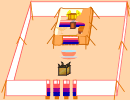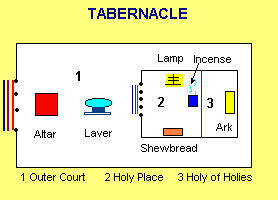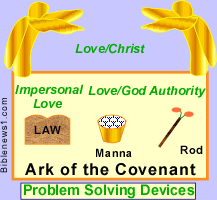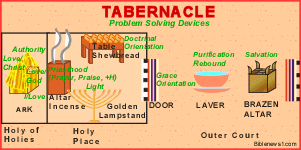In His Sovereign Design, or eternal, holy, and wise master plan, God included a way for undeserving mankind to have a relationship with Him. And the relationship is not only functional, it is the highest, noblest, kindest, closest, most unbelievable, wonderful love relationship imaginable. It is so wonderful that the marriage relationship with super love and happiness, a la Garden of Eden, was invented just to illustrate it.
God's Sovereign Design is big. It encompasses the entire universe - the farthest star, the highest mountain, the deepest sea. It includes the infinite and the infinitesimal: the distant star, the smallest atom and quantum of matter and energy. It includes all that has life and all that is lifeless. It includes angels, mankind, plants, and animals. In the midst of this gigantic Design, God has placed mankind and has decided to share some of the infinite knowledge and mysteries of this creation with him. This is all grace, freely bestowed. It all depends on God. Mankind never earned or deserved anything.
Grace is the natural consequence of the Sovereignty of God. From His Sovereignty, God designed everything that would ever exist. He created everything per the master Design, and His policy toward all Creation is grace. God freely gave everything that He previously designed. Orienting to God's policy of Grace is a requirement for fulfilling the Christian life.
![]()
God's Plan, even in the Garden of Eden, had boundaries (illustration). There was a tree in the middle of the Garden from which Adam and 'Ishah were not permitted to eat. This would constitute sin, and sin would cause spiritual death and eventually physical death. The Hebrew doubling of muth (Genesis 2:17) means literally, "dying you will die," i.e. "dying spiritually, you will also die physically." God's Plan in the Garden was grace, and grace has boundaries. Anything outside the boundaries is a violation of the grace of God. So, from the Garden, we learn that compliance with the grace of God means doing it God's way. Any other way can have dire consequences.
On the one hand the Garden of Eden was the example of the perfect relationship - a man and a woman in a perpetual honeymoon with love and happiness - no work - perfect environment. This was a magnificent demonstration of God's grace on the first man and women created. It was a beautiful illustration of a perfect marriage and all that man really needs to make him happy. As long as he obeyed the mandates of God and did not overstep the boundaries of grace, it was the best of the best. However, when man violated the commandments of God, then the consequences were dire. The whole world reeled under the impact of sin. Not only did man lose his spiritual relationship with God, the animals and all of nature suffered also (Romans 8:20-22).
After Adam's original sin, the problem of providing a relationship between God and man was more difficult, but God provided a Plan in grace to solve this difficult problem. It was the problem of salvation for mankind. God offered mankind a way to be saved out of this terrible mess of sin and eternal condemnation. God would provide a redeemer to pay for man's sins, and if man would accept the work of the Redeemer, who would be the man from Jehovah, then man could be saved, spiritually renewed. Adam and the woman accepted God's offer of salvation through the work of the Jehovah-man who would come and pay for the sins of the world. The Jehovah-man who was to come was none other than the Lord Jesus Christ, who would die on Calvary's cross as a substitute for all mankind.
The Lord then gave Adam and Eve a new grace plan called
the Adamic Covenant. There was in this covenant a promise of the
new Savior who would come to bear the sins of the world. This Savior
would be born of the seed of the woman (Genesis 3:15),
Eve, "mother of all living" (Genesis 3:20).
And there were new boundaries of the grace of God. For one thing,
the man and his wife were booted out of the Garden of Eden (Genesis
3:23-24). They lost the benefits of living in a paradise without
sin. They were kicked out into fields that would have to be tilled
in the midst of a nature with wild animals and weeds, thorns, and thistles
(Genesis 3:17-19). And the woman would
have to bear children to counter the problem of physical death (Genesis
3:16).
 The
Tabernacle of Israel is perhaps the best illustration of the Design of
God in the Bible. It is a simple illustration of the grace of God
in providing a way to have a relationship with mankind. The Tabernacle
was part of the Covenant that the Lord made with Moses, which was called
the Law, or Mosaic Law. The Law included ritual for worship.
The center of the ritual was the Tabernacle. The plan of the Tabernacle
illustrated the grace of God in providing a dwelling among mankind.
The
Tabernacle of Israel is perhaps the best illustration of the Design of
God in the Bible. It is a simple illustration of the grace of God
in providing a way to have a relationship with mankind. The Tabernacle
was part of the Covenant that the Lord made with Moses, which was called
the Law, or Mosaic Law. The Law included ritual for worship.
The center of the ritual was the Tabernacle. The plan of the Tabernacle
illustrated the grace of God in providing a dwelling among mankind.
"It has ever been the desire of Almighty God to dwell in the midst of His people."1 In order to do so, the Lord gave Moses the plan for the Tabernacle and He cautioned Him (Exodus 25:40 as quoted in Hebrews):
 The
Tabernacle was a tent that was pitched in the midst of the camp of Israel
during the wilderness wanderings. The layout was simple, as shown
in the illustration. Note: Some other resources
which are not part of this article have been done by others.2
There was a wall of linen five cubits high (7.5 feet) that established
the boundaries of the Tabernacle, which was 150 X 50 cubits (or 225' x
75') (Exodus 27:18). Why would God,
if He wanted to dwell among His people, erect a 7.5' perimeter fence around
it? There are two reasons: (1) To keep the people out,
and (2) to control access.
The
Tabernacle was a tent that was pitched in the midst of the camp of Israel
during the wilderness wanderings. The layout was simple, as shown
in the illustration. Note: Some other resources
which are not part of this article have been done by others.2
There was a wall of linen five cubits high (7.5 feet) that established
the boundaries of the Tabernacle, which was 150 X 50 cubits (or 225' x
75') (Exodus 27:18). Why would God,
if He wanted to dwell among His people, erect a 7.5' perimeter fence around
it? There are two reasons: (1) To keep the people out,
and (2) to control access.
The white wall of linen marked the boundary between sanctified, or holy, ground on God's side versus the world on the outside. The world was not allowed to have fellowship with God. Only recipients of the grace of God were allowed access to Him. All others stayed out. To violate God's procedures meant instant death. Only Moses and the Levitical Priesthood were allowed access to the Tabernacle and they had to follow specific procedures (ritual) or it meant instant death.
There were three major parts of the Tabernacle:
 Every
part of the Tabernacle and each article of furniture represented the Lord
Jesus Christ, the God-man, and work of salvation.
Every
part of the Tabernacle and each article of furniture represented the Lord
Jesus Christ, the God-man, and work of salvation.
The curtains of the Tabernacle marked off the boundaries of the grace of God. To violate these boundaries in any way meant instant death (Exodus 28:35, 43; 30:20, 21; Leviticus 8:35; 10:6-9; 16:2, 13; 4:15-20; 17:10; 18:3-30). The outer wall of linen separated the dwelling of God from the world. The curtain of the Gate with four colors marked the way of salvation. The Door of the Holy Place with five posts represented Grace Orientation. The Veil of the Holy of Holies separated man from the presence of the Holy and Righteous God, who dwelt between the Cherubs of the Mercy Seat as the Shekinah Glory, the preincarnate manifestation of the Lord Jesus Christ.
Entering the curtain of the Gate represents the decision to believe in Christ for salvation. It represents man's decision to accept the work of Christ for salvation because directly inside the Gate was the Brazen Altar, a symbol of Christ, our sacrifice. Thus, the first aspect of the grace of God for mankind illustrated by the Tabernacle was the provision of salvation. There is only one way of salvation, and that is reliance upon the work of Christ on the cross as symbolized by the Brazen Altar where animals were sacrificed. The blood of the animal represented the blood of Christ, who provided redemption for our sins.
Salvation is all of grace. Mankind does nothing to earn or deserve salvation.
Positional sanctification occurs at the moment of salvation when the believer is Baptized with the Holy Spirit (Acts 1:5; Romans 6:3; 1 Corinthians 12:13; Galatians 3:27) and thereby entered into union with Christ positionally (Galatians 3:28). In other words, the believer in Christ is set apart as belonging to Christ at salvation (Romans 15:16; 1 Corinthians 1:2). Sanctification means to be set apart (Hebrews 2:11). The believer is set apart from the world. Positional sanctification (1 Corinthians 6:11) is part of the completed work of Christ on the cross, which means that the believer is sanctified by God's work (Ephesians 2:8-9; Hebrews 2:11) at the moment of salvation. He can never lose his salvation because the work of salvation is complete the moment He believes in Christ (Hebrews 10:14). There is nothing that needs to be added (Hebrews 10:10). It does not matter what happens after salvation (Hebrews 10:29); when the believer dies, he will go to heaven regardless of his circumstances (John 10:28).
The Levitical Priests were washed all over once (Exodus 29:4; 40:12) to symbolize their positional sanctification (Titus 3:5). Thereafter, they washed their hands and feet in the Laver (Exodus 30:19-20), which symbolized experiential sanctification. Experiential sanctification for the believer is required every time he sins after salvation. The recovery procedure that must be followed when a person sins is called the Rebound Procedure. To Rebound, the believer who has sinned must name his sins to God per 1 John 1:9.
This simple, non-meritorious procedure which is practiced out of fellowship illustrates God's grace provision for living the Christian life, which is a supernatural way of life that requires a supernatural means of execution. In Israel fellowship with God did not mean the Filling of the Spirit; but it was, nevertheless, required in order to execute the Plan of God in submission to divine authority. The difference in Israel was that after Rebound an animal sacrifice had to be offered by the Priest. In the Church Age that is not required because the Lord Jesus Christ paid for all sins on the cross.
The furniture of the Holy Place illustrated God's grace provision for executing the spiritual life after salvation. The second entrance of the Tabernacle was another unique entrance, the only one into the Holy Place. Clearly marked with the Blue, Purple, Scarlet, and Fine Linen, it revealed the second most important decision in life. First was Salvation by Grace and second was Grace Orientation for the spiritual life. The illustration was a believer feasting on the Word, walking in the Light, and praying to his Heavenly Father.
The Veil in the Tabernacle, however, was necessary to protect mankind from God. The Lord Jesus Christ dwelt between the Cherubs on the Mercy Seat behind the Veil. To come into His presence without following the grace procedures would have meant instant death. The Veil also illustrated the separation between a Holy God and sinful mankind in a totally depraved state.
The Ark of the Covenant (Exodus 25:10-22) inside the Holy of Holies represented Christ our all in all as well as the fruit of the Spirit of the adult Christian life. All that we have in our grace relationship with God is compliments of the Lord Jesus Christ. The Ark was made of acacia wood overlaid with gold. The wood represented the humanity of Christ and the gold, the deity. The combination represented the Lord Jesus Christ, the uniquely born Son of God in Hypostatic Union - perfect humanity and undiminished deity. The Lord Jesus Christ was uniquely qualified to satisfy the demands of a Holy and Righteous God and bear the sins of the world. As deity, He was equal with God. As humanity, He was equal with mankind. As deity, He was acceptable to God. As humanity, He could represent mankind. The Lord Jesus Christ, thus, became the mediator between God and man.
A mediator is a person who brings two groups together similar to an arbiter. An arbiter is one whom both parties trust, and a mediator is similar. However, in the case before us, the two parties are God and mankind. The problem is that God is absolute righteousness and His perfect justice can have nothing to do with sin. To come into God's presence with sin would mean instant death. So the mediator had to be equal with God to be acceptable to Him and equal to mankind to be able to represent them. The perfect humanity of Jesus Christ is the only one who could meet these criteria. So Christ became the perfect mediator. The mediation required the payment for the sins of the world to satisfy the demands of a righteous God. By the work of Christ on the cross, He reconciled all mankind to Himself. Christ was perfect righteousness; so He was acceptable to God.
Mankind was reconciled to Christ, and God accepted mankind as being in Christ. So mankind was reconciled to God on the basis of the substitutionary sacrifice of Christ for the sins of the world.
 The Ark
of the Covenant contained three things: A golden pot of manna, Aaron's
rod that budded, and the Tablet of the Ten Commandments (Hebrews
9:4). The Ark was covered with a Mercy Seat of pure gold,
which represents Christ, our propitiation (Romans
3:25; Hebrews 9:5 Greek). The blood was sprinkled on the Mercy
Seat on the Day of Atonement; and God was satisfied, which means that God
the Father was satisfied (propitiated) by the work of Christ on the cross
on behalf of mankind.
The Ark
of the Covenant contained three things: A golden pot of manna, Aaron's
rod that budded, and the Tablet of the Ten Commandments (Hebrews
9:4). The Ark was covered with a Mercy Seat of pure gold,
which represents Christ, our propitiation (Romans
3:25; Hebrews 9:5 Greek). The blood was sprinkled on the Mercy
Seat on the Day of Atonement; and God was satisfied, which means that God
the Father was satisfied (propitiated) by the work of Christ on the cross
on behalf of mankind.

The second Problem Solving Device is purification (or sanctification), as symbolized by the Laver. At Salvation a person is forgiven of his sins and purified from all unrighteousness. The purified person is entered into union with Christ, which is called Positional Sanctification. The believer's position in Christ never changes, even when he sins. However, sins deprive the believer of fellowship with God in this life. Since the sins were paid for on the Cross, the believer in sin can follow a recovery procedure called Rebound. When he names his known sins, God will forgive them and purify him from all wrongdoing. Rebound restores the Filling of the Holy Spirit in the believer and restores him to fellowship with God.
The third Problem Solving Device is Grace Orientation, as symbolized by the Door. God's Plan for the believer requires that God do the work, which is Grace. Executing the new Spiritual life requires orienting to the Grace of God in all things.
For the Church Age Believer, the Holy of Holies represents the Adult Spiritual Life while the Holy Place represents Spiritual Childhood. Spiritual Childhood is characterized by:
The Altar of Incense is another Problem Solving Device. It symbolizes the function of the Priesthood of the believer. Every believer in the Church Age is a priest. A priest is one who represents himself and others to God. There are many functions of the Priesthood. This has nothing to do with religions who call the clergy priests. That is usually apostasy based upon confusion over the Old Testament Law. We are not under the Law in the Church Age. Some of the functions of the Priesthood include prayer, praise, and sharing the Happiness of God. God's Happiness (+H) is always available as a Problem Solving Device. Jesus Christ used it on the Cross (Heb 12:2). Other functions of the Priesthood include Ambassadorship, service, singing, and music.
The Golden Lampstand symbolizes the Problem Solving Device of Light. The believer who is enlightened avoids the darkness of the Cosmic System. The Lampstand includes both tactical and strategic advance:
Grace is the free gift of God. It has also been called God's unmerited favor on us undeserving sinners. Spiritual Adulthood is characterized by the fruit of the Spirit (Galatians 5:22), maximum production and love. The Holy of Holies represented both the Love relationship with the Godhead, Impersonal Love for all mankind, and bearing fruit. Aaron's rod that was kept in the Ark of the Covenant had budded, blossomed, and bore fruit (e.g. almonds). This rod was kept in the Ark as a symbol of divinely ordained authority and fruit bearing (grace production).
Because whom He has foreknown, He has also predestined to be conformed to the image of His Son, that He might be the firstborn among many brethren (Romans 8:29)
That I may come to know Him, and the power of His resurrection, and the fellowship of His sufferings, having become like Christ with reference to His death (Philippians 3:10).
![]()